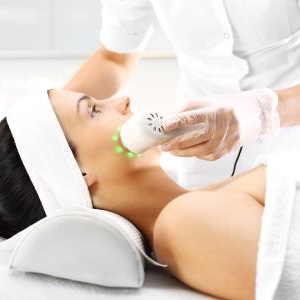Photodynamic therapy, known also as PDT, is a type of dermatologic treatment that can be tailored to correct conditions such as acne, precancerous lesions, and sun damage. This form of treatment combines a special type of light with innovative photosynthesizing agents to target specific skin cells.
Blue light therapy for acne
Most adolescents and adults struggle with acne at one point or another. Though not a serious health condition, acne can cause a great deal of emotional turmoil. This condition also carries the risk of temporary or permanent scarring, posing a threat to self-esteem and a positive self-image. Suitable acne treatment is designed to improve the health of the skin, thus minimizing the appearance of breakouts and scarring. In some cases, topical and oral medications are not enough to produce the desired result. In some cases, we may suggest blue light therapy as a safe, effective acne treatment.
Photodynamic therapy with blue light targets P. acnes, the type of bacteria that leads to inflammation in the pores. This type of bacteria produces porphyrin, tiny molecules that irritate the skin. Exposing porphyrin to blue light elicits the production of free radicals, which creates a toxic environment within bacteria-filled pores. P. acnes cannot live in this toxic environment, and are quickly destroyed. With the elimination of P. acnes, skin becomes clearer and healthier. With blue light therapy, active lesions are treated and future lesions prevented.
Blue light therapy, which is provided in a series of comfortable sessions, exposes the skin to high-intensity blue light for a period of about fifteen minutes each session. Sessions are scheduled at a frequency based on the severity of acne and the desired outcome. This treatment may be combined with others, such as Levulan® (aminolevulinic acid) topical medication, which increases photosensitivity before exposure to blue light.
Benefits of blue light therapy:
- No downtime
- Painless, non-invasive treatment
- Safe and effective for patients of all ages
- 100 percent natural, drug-free treatment with no side effects
Blue light therapy has been used in the treatment of acne for more than a decade. This safe, effective treatment can produce an immediately noticeable improvement, with progressive results that improve with subsequent sessions. Some individuals who have completed ten treatments have remained acne-free for up to two years. Others have required occasional maintenance treatments to keep skin looking its best.
Levulan PDT System
In addition to treating acne, photodynamic therapy may also treat precancerous lesions called actinic keratoses, or AKs, in a non-surgical manner. Actinic keratoses typically appear on the scalp, face, hands, or arms, areas that are regularly exposed to the sun. Looking like rough patches of skin, AKs are a direct result of sun damage, but may not appear until mid-life, when years of exposure has affected skin cells. A precancerous lesion may be red or may be the same tone as surrounding skin, merely appearing scaly. Some AKs have the potential for growth and development into squamous cell carcinoma, a type of skin cancer that may require surgical treatment.
AK lesions are treated with a combination of Levulan® Kerastick® and blue light illumination or intense pulsed light, two therapies that are effective at destroying precancerous lesions without harming healthy skin cells. Treatment begins with the application of this topical medication as discussed during consultation with Dr. Koreen. Levulan® Kerastick® contains aminolevulinic acid, a type that is naturally produced in the body, causing photosensitivity.
Medication is left on the skin for a period of time lasting up to an hour, after which light will be directed via the BLU-U™ Blue Light Photodynamic Therapy Illuminator for just a few minutes. This process has been proven effective for the treatment of precancerous growths, with many patients experiencing complete clearing within four weeks of treatment. This type of photodynamic therapy is also commonly used for full-face rejuvenation, taking up to several months to achieve optimal results.
For the first two days after treatment, skin should be protected from further sun damage with protective clothing such as long sleeved tops and wide-brimmed hats as much as possible. Sunscreen alone is not sufficient for protecting treated areas from sensitivity to light.
Precancerous growths
Precancerous growths, areas of skin that appear slightly rough or discolored, are a direct result of sun exposure and damage. A major concern about AK precancerous growths is that, in a larger quantity, these growths are more likely to develop into skin cancer called squamous cell carcinoma. It is estimated that as much as 20 percent of precancerous lesions develop into skin cancer.
We design treatment plans based on the severity of each patient’s condition. Precancerous lesions may also be treated with cryotherapy using liquid nitrogen or topical medications, with or without photodynamic therapy.
Dr. Koreen and his experienced staff can help you handle acne, precancerous growths, and a variety of other dermatologic concerns. Call our office at (631) 417-3300 to arrange your consultation.













